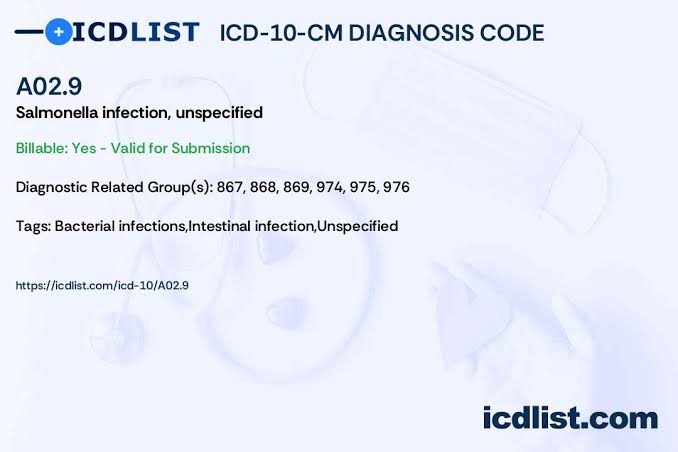We’ve all been there. A few hours after a questionable picnic or a undercooked meal, your stomach begins to revolt. While we often dismiss it as a simple “case of food poisoning,” the medical world classifies these events with remarkable precision. When it comes to one of the most common and serious culprits—Salmonella—the diagnostic code is A02.0: Salmonella enteritis.

But this code is more than just a number on a chart. It’s a gateway to understanding a complex bacterial infection that impacts millions worldwide. Let’s dive deeper into what this code represents, the science behind the sickness, and why proper coding is crucial for public health.
Deconstructing the Code: A02.0
The ICD-10 (International Classification of Diseases, 10th Revision) is the global standard for diagnosing everything from a common cold to rare cancers. The code for Salmonella food poisoning is specifically broken down as:
- Chapter I: Certain infectious and parasitic diseases (Codes A00-B99)
- Block: Other intestinal infectious diseases (A00-A09)
- Specific Code: A02.0 – Salmonella enteritis
The term “enteritis” is key. It means inflammation of the intestine, specifically the small intestine, which is precisely what the Salmonella bacteria causes, leading to the classic symptoms of diarrhea, abdominal cramps, and vomiting.
Important Coding Note: It is critical for medical coders to use an additional code from Chapter 20 (External causes of morbidity) to identify the specific food that was contaminated (e.g., W61.62XA, Contact with turkey; Y93.53, Activity, grilling and smoking food). This practice is vital for tracking outbreaks.
The Unseen Battle: What Salmonella Actually Does in Your Body
Salmonella isn’t merely “spoiled food” irritating your stomach. It’s a sophisticated pathogen. When you ingest food or water contaminated with Salmonella bacteria (often from raw poultry, eggs, beef, or unwashed produce), they survive the acidic environment of your stomach and travel to your intestines.
Here, they invade the cells lining your intestinal wall. Your body’s immune system detects this invasion and launches a massive inflammatory response to fight off the bacteria. This inflammation is what causes the primary symptoms—it’s your body trying to flush out the invaders as quickly as possible through diarrhea and vomiting.
For most healthy adults, this is an intense but short-lived battle. However, for vulnerable populations—the young, the elderly, and the immunocompromised—the bacteria can escape the intestines, enter the bloodstream (a condition called bacteremia), and cause a life-threatening systemic infection that requires urgent medical attention.
Beyond the Individual: Why Accurate Coding Matters
Coding a case as A02.0 does more than just facilitate a patient’s billing. It acts as a critical data point in a vast public health surveillance system.
- Outbreak Detection: When multiple cases of A02.0 are reported in a specific geographic area within a short time, epidemiologists can connect the dots. By interviewing patients and identifying the common food source (using those external cause codes), they can trace the outbreak to a specific farm, processing plant, or restaurant.
- Product Recalls: This data is what triggers the FDA and USDA to issue urgent food recalls, pulling contaminated products off supermarket shelves and preventing thousands of additional illnesses.
- Policy and Prevention: Long-term data on Salmonella infections helps shape food safety regulations and guidelines for producers, processors, and consumers.
In essence, that small code on a medical chart is a silent sentinel, helping protect the community at large.
Frequently Asked Questions (FAQ)
Q1: What’s the difference between “food poisoning” and “Salmonella”?
A: “Food poisoning” is a broad, non-medical term for illness caused by eating contaminated food. It can be due to various bacteria (like E. coli or Listeria), viruses (like Norovirus), or toxins. Salmonella is one specific type of bacteria that is a leading cause of bacterial food poisoning.
Q2: Are there other ICD-10 codes for different types of Salmonella infections?
A: Yes, absolutely. This is a key point. The ICD-10 system is highly specific. While A02.0 is for intestinal Salmonella (enteritis), other codes include:
A02.1: Salmonella sepsis (when the infection spreads to the blood)
A02.2: Localized salmonella infections (e.g., infections in joints or bones)
A02.8: Other specified salmonella infections
A02.9: Salmonella infection, unspecified
Q3: I think I have Salmonella food poisoning. When should I go to the doctor?
A: Seek medical attention if you experience:
Symptoms lasting more than 3 days
Signs of dehydration (dry mouth, little urination, dizziness)
A fever higher than 102°F (38.9°C)
Bloody diarrhea
Severe vomiting that prevents you from keeping liquids down
Q4: How is Salmonella treated?
A: For uncomplicated cases, treatment focuses on preventing dehydration by drinking water, clear broths, or electrolyte solutions. Antibiotics are typically not recommended for mild cases as they can prolong the duration of bacterial shedding and contribute to antibiotic resistance. They are reserved for severe cases or high-risk patients.
Q5: How can I prevent Salmonella infection?
A: The four key steps are:
Clean: Wash hands, utensils, and surfaces often.
Separate: Keep raw poultry, meat, and eggs separate from ready-to-eat foods.
Cook: Cook food to the right internal temperature (165°F or 74°C for poultry).
Chill: Refrigerate perishable foods within two hours.
Disclaimer:
This article is for informational purposes only and does not constitute medical advice. Always consult with a qualified healthcare professional for diagnosis and treatment of medical conditions.